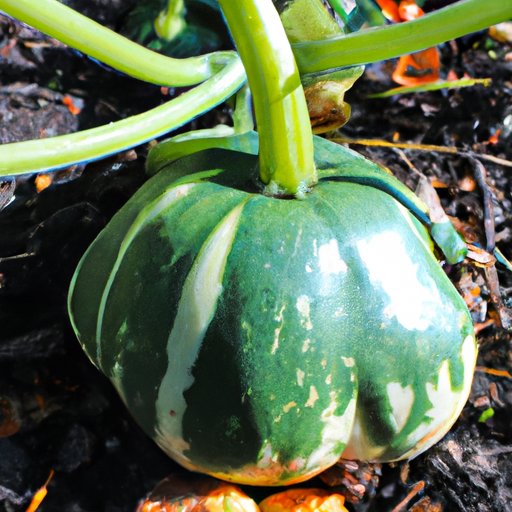Introduction
Are you considering growing your own pumpkins but don’t know where to start? Growing pumpkins can be a fun and rewarding experience. They are not only great for autumn decorations, but they are also delicious in recipes. In this article, we will guide you through a comprehensive step-by-step guide on how to grow pumpkins, the benefits of growing your own pumpkins, how to use pumpkins in creative ways, overcoming common pumpkin growing challenges, and how to decorate with pumpkins.
Step-by-Step Guide to Growing Pumpkins
Seed Selection
The first step to growing pumpkins is selecting the right seeds. Choose pumpkin varieties that are well-suited to your climate, and ensure that they are fresh, healthy, and disease-free. Pumpkins come in a variety of shapes, sizes, and colors. Some popular pumpkin types include Sugar Pie, Jack O’ Lantern, and Baby Pam.
Soil Preparation
Pumpkins thrive in well-drained soil that is rich in nutrients. Prepare your soil by removing weeds and adding organic matter such as compost or well-rotted manure. Pumpkins prefer soil that has a pH between 6.0 and 7.0.
Planting
You should plant your pumpkin seeds outdoors after the last frost. Plant seeds one inch deep, and make sure that they are well-watered. Pumpkin seeds should be spaced 3-5 feet apart to allow for proper growth and access to sunlight.
Watering
Pumpkins require regular watering throughout their growing season. Water deeply once a week, making sure that the soil is moist to a depth of at least six inches. Avoid overwatering, as this can lead to disease and root rot.
Fertilizing
Pumpkins need plenty of nutrients to grow properly. Feed your pumpkin plants with a balanced fertilizer at least once a month. You can also use compost or well-rotted manure to provide additional nutrients.
Pest Control
Pumpkins are susceptible to a range of pests, including aphids, spider mites, and squash bugs. You can protect your plants by using insecticidal soap or neem oil, and by removing any infected leaves or fruits.
Harvesting
Most pumpkins take around 90-120 days to mature. You can tell when your pumpkin is ready to be harvested by tapping it lightly with your finger. If it sounds hollow, it is ready to be cut from the vine. Be sure to leave a few inches of stem attached to the pumpkin, as this will help to prolong its shelf life.
Benefits of Growing Pumpkins
Cost Savings
Growing your own pumpkins can save you money in the long run. You will not need to purchase pumpkins for autumn decorations, and you can also enjoy homegrown produce throughout the season.
High-Quality, Fresh Produce
Homegrown pumpkins are fresher and higher in quality than store-bought pumpkins. You can also control the use of pesticides and chemicals.
Rewarding Experience
Growing your own pumpkins can be a fun and rewarding experience. It is a great way to connect with nature and learn about the process of growing fruits and vegetables.
Creative Ways to Use Pumpkins
Pumpkin Pie Recipes
Pumpkins are delicious in pies, and there are many variations of this classic dessert. You can try adding spices such as cinnamon and nutmeg, or experiment with different crusts and toppings.
Pumpkin Soup Ideas
Pumpkins also make delicious soups. You can puree roasted pumpkin with vegetable or chicken broth, and add herbs and spices such as thyme, sage, and cumin.
Pumpkin-based Main Dish Suggestions
Pumpkins can also be used in savory dishes such as stews, curries, and pasta bakes. You can try roasting pumpkin cubes and adding them to your favorite dish.
How to Overcome Common Pumpkin Growing Challenges
Diseases
Pumpkins are susceptible to a range of diseases such as powdery mildew and bacterial wilt. You can prevent these diseases by practicing good crop rotation and using disease-resistant cultivars.
Pests
Pests such as aphids and squash bugs can cause damage to your pumpkin plants. You can control these pests by using insecticidal soap or neem oil, and removing any infected parts of the plant.
Adverse Weather Conditions
Pumpkins can be affected by extreme weather conditions such as frost, drought, and heatwaves. You can protect your plants by covering them with blankets or cloths during cold weather, and watering them regularly during periods of drought.
How to Decorate with Pumpkins
Pumpkin Carving Ideas
Pumpkin carving is a fun and traditional way to decorate your home for the fall season. You can carve different designs and shapes, or try using stencils for more detailed carvings.
Autumn-themed Centerpieces
Pumpkins can also be used as part of autumn-themed centerpieces. You can pair them with fall foliage, acorns, and other seasonal elements for a festive and cozy display.
Conclusion
Growing pumpkins is a fun and rewarding experience that can save you money and provide you with high-quality, fresh produce. By following our step-by-step guide, you can successfully grow pumpkins in your backyard. Remember to use pumpkins in creative ways, overcome common challenges, and decorate with them for a festive and cozy home.
